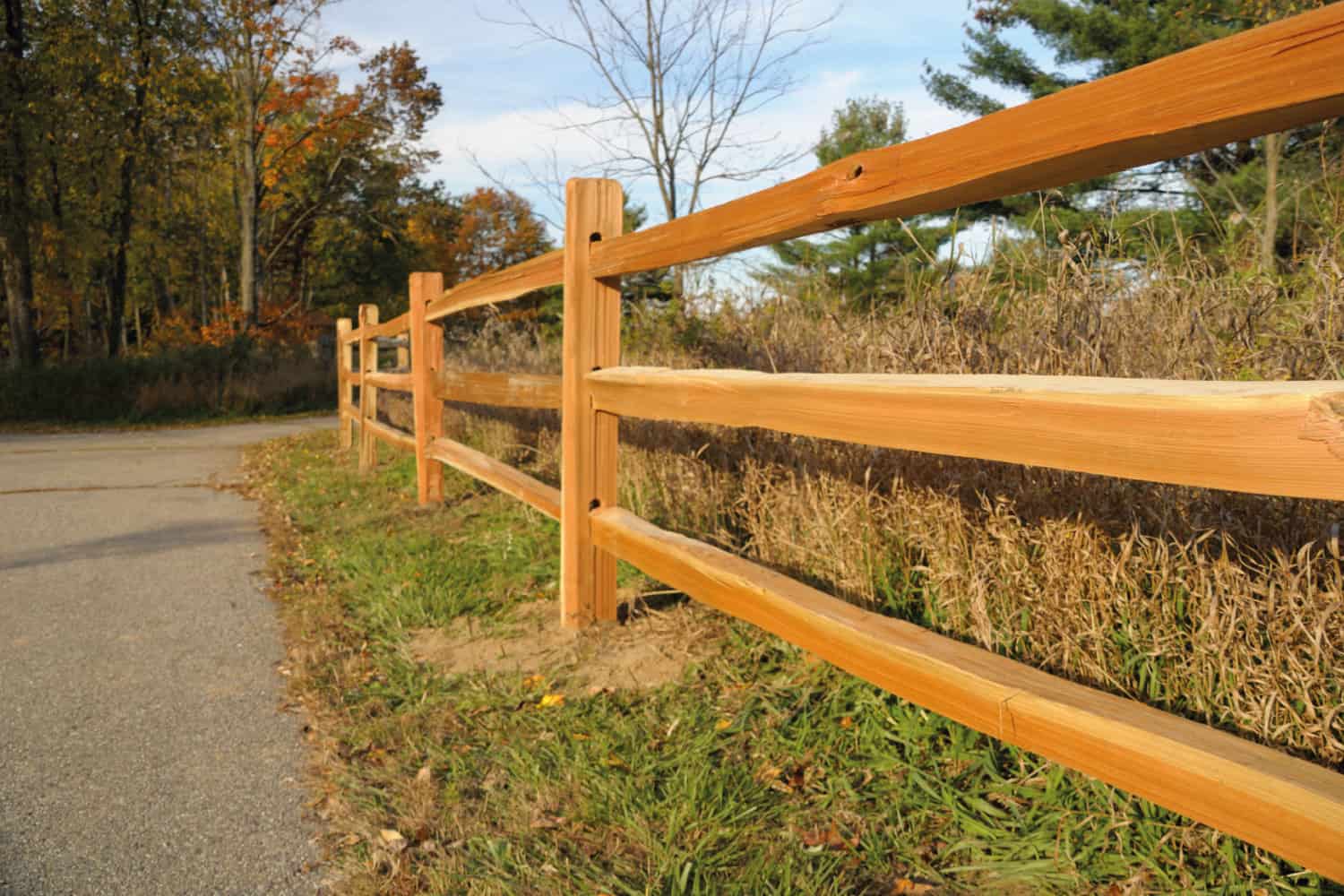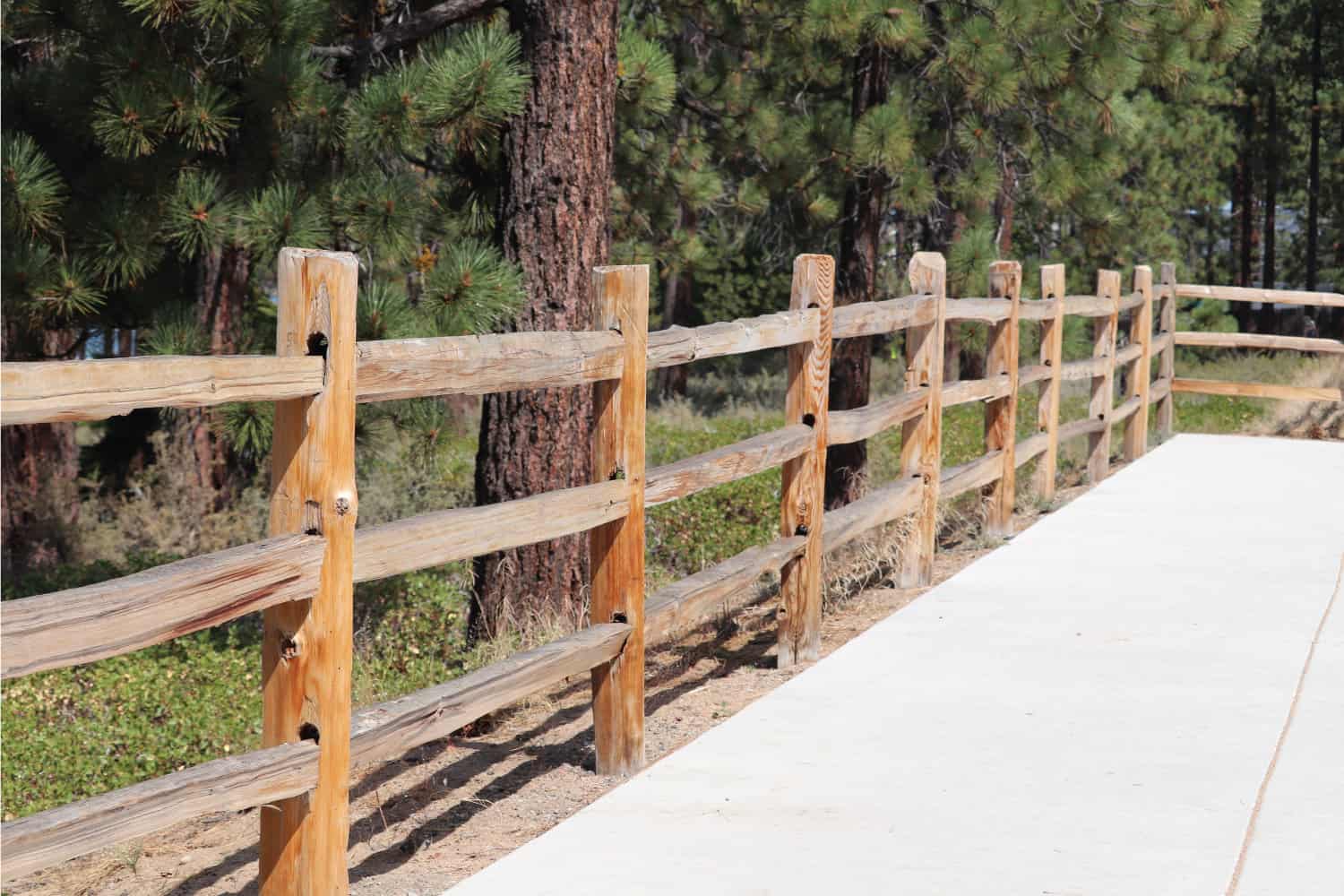Installing a split rail fence can be a great way to mark your property’s boundaries. But now you’re thinking about the best wood to use for this type of fencing. We researched some great options for you and here’s what we found.
Some ideal wood candidates you may want to check out for your split rail fence are:
- American chestnut
- Black locust
- Western red cedar
- Yellow pine
Take note that certain choices might be challenging to find and/or use to construct wooden structures. So continue reading as we talk about these split rail fence wood choices in greater detail.
We’ll also discuss the general steps to make split rail fencing for your convenience.
What Is The Best Wood For A Split Rail Fence?
Different wood options are available to use for split rail fences. Some possible yet great selections you might consider are:
1. American Chestnut
Lumber from the American chestnut tree can be an excellent choice for a split rail fence. It’s aesthetically pleasing, and it possesses rot-resistant properties.
Many people would use the wood from this tree for a range of applications, including vineyard stakes and split rail fences.
However, it can be tough to find good American chestnut trees and lumber at the time of writing. Back in the first half of the 20th century, a blight swept across these trees, causing massive destruction to their population.
Thankfully, efforts to reintroduce the tree to the commercial market have been in progress for some time. So if you plan on making a split rail fence with an American chestnut tree, make sure to consult and follow agriculture guidelines to avoid legal consequences.
2. Black Locust
Defined by its highly durable and rot-resistant nature, the black locust tree can be an ideal choice to make split rail fences. It has good weather-resistant traits, and it’s also usable in other outdoor wooden applications.
In particular, the black locust’s aggressive rot resistance comes from its Lignin content. This substance allows chemicals to soften and dissolve within the tree’s heartwood, promoting excellent longevity.
Also, dihydrorobinetin and robinetin are within the black locust’s chemical construct. These two chemical compounds are flavonoids that act to eliminate wood-destroying fungi.
Plus, the amount of these flavonoids increases as the tree grows old, making black locust lumber more valuable as it ages.
Check out these black locust tree seeds on Amazon.
3. Western Red Cedar
Western red cedar trees have good weather resistance but often grow in locations with cold and damp climates. Identified as a medium- to large-sized tree, it can grow up to about 197 feet tall with proper care.
Longevity is another defining feature of western red cedar lumber. If grown under the appropriate living conditions, it can live up to approximately 1,000 years.
With these traits, lumber from this tree can be a good choice for building a split rail fence that can last generations.
However, western red cedar lumber has some shortcomings. For instance, its soft construction might make it easy to dent or scratch.
On the other hand, this caveat may also provide flexibility and versatility to the wood, allowing it to offer different applications like fencing and patio decking.
Check out these western red cedar shakes on Amazon.
4. Yellow Pine
Yellow pine’s durability often fills split rail fence builders, installers, and users with awe. It typically has a Janka hardness rating of 870, which makes it one of the toughest woods to use for fencing and other wooden applications.
It’s important to mention that the Janka hardness scale uses proprietary tests to check wooden samples’ resistance to dents and wear. With that test, experts were able to compare yellow pine with other hardwood samples, such as black walnut and white pine.
In those tests, black walnut lumber has a standard Janka hardness score of 1010. On the other hand, white pine only has a 420 Janka rating.
Upon close inspection, yellow pine is in the middle of these two timber options, allowing it to be a good, if not a great option for building outdoor split rail fences.
Can I Make My Own Split Rail Fence?
A split rail fence’s design makes it relatively easy to complete for DIY beginners and experts. However, some particulars need to exist before starting this project, such as:
- A clear indication of the property’s lines
- Strict compliance with building codes
- Being a good neighbor
If you wish to continue with this project, make sure you follow proper safety protocols to avoid serious accidents and injuries. One piece of equipment that you should wear is safety glasses or goggles, especially if you're going to chop wood for the fencing.
After finishing the preparations, here are the steps to make the fence:
What You’ll Need
- String
- Earth auger
- Gravel
- Measuring tape
- Level
- Lumber of your choice
Step-by-Step Guide
- Measure and mark your property’s borders.
- Mark the locations for the stakes and string.
- Dig the marked areas for the post poles with the earth auger.
- Fill the holes with gravel.
- Start inserting timber posts into the holes. Begin this step from the end posts.
- Insert the rails into the holes of each post.
Check out this post hole auger on Amazon.
Don't forget to watch the video below to learn additional details about this procedure. The person in the video also highlights the steps to create the pieces for the split rail fencing:
At this point, you might also be wondering if you can build a fence on a drainage easement. If so, our post on that subject matter will give you the answer.
How Long Does Cedar Split Rail Fence Last?
Cedar lumber used for a split rail fence often lasts about 15 years. Some cedar species, such as western red cedar, may last longer than that period.
Also, watch this video to learn about how to protect outdoor cedar structures in the winter:
If you want to learn more about the longevity of different privacy fences, check out our post on that particular topic.
How Much Does A Split Rail Fence Cost Per Foot?
Split rail fencing material costs generally range from $11 to $29 per linear foot. Property owners should expect to spend about $20 per linear foot on average to purchase the lumber to build this structure.
However, the overall expenses could increase if professional labor is present. If so, homeowners should expect to pay between $1,782 and $3,923 to complete this project with the help of experts.
It’s also possible for the overhead to go over $23,000 if high-end materials and services exist for the procedure.
Are Split Rail Fences Good?
Split rail fences offer fairly distinct advantages to properties. Some of these possible benefits are:
- Affordability: Split rail fencing costs are usually less expensive than other options like brick, stone, and concrete.
- Safety: If built properly, split rail fences can help keep children and animals within the property without promoting high risks of harm.
- Homey look: Split rail fences often increase the visual aesthetic of certain property designs with their rustic appearances.
Final Words
Those interested in making and installing split rail fences can choose from different lumber options for these structures. Black locust, western red cedar, and yellow pine are excellent candidates for these projects.
Wood from the American chestnut is also a good option, albeit lumber from this tree can be quite difficult to find and purchase.

![stacks of lumber to be used as split rail fence. Image samples of American chestnut Black locust Western red cedar Yellow pine. Best Wood For Split Rail Fences [4 Great Options!]](https://fencefixation.com/wp-content/uploads/2022/06/stacks-of-lumber-Image-samples-of-American-chestnut-Black-locust-Western-red-cedar-Yellow-pine-Best-Wood-For-Split-Rail-Fences-4-Great-Options.png)






![assorted wood material like planks, squares, sheets. Timber for carpentry. Best Wood For Split Rail Fences [4 Great Options!]](https://fencefixation.com/wp-content/uploads/2022/06/assorted-wood-material-like-planks-squares-sheets.-Timber-for-carpentry.-Best-Wood-For-Split-Rail-Fences-4-Great-Options.png)
![A grass meadow and a small fence next to a small pond, How Long Does Split Rail Fence Last? [And How To Prolong Its Life]](https://fencefixation.com/wp-content/uploads/2022/06/A-grass-meadow-and-a-small-fence-next-to-a-small-pond-600x400.jpg)

![White rail fence leading along cornfield and deep blue sky. How Tall Are Split Rail Fences [Inclding 2, 3, & 4 Rail Heights]](https://fencefixation.com/wp-content/uploads/2022/06/White-rail-fence-leading-along-cornfield-and-deep-blue-sky.-How-Tall-Are-Split-Rail-Fences-Inclding-2-3-4-Rail-Heights-600x400.png)